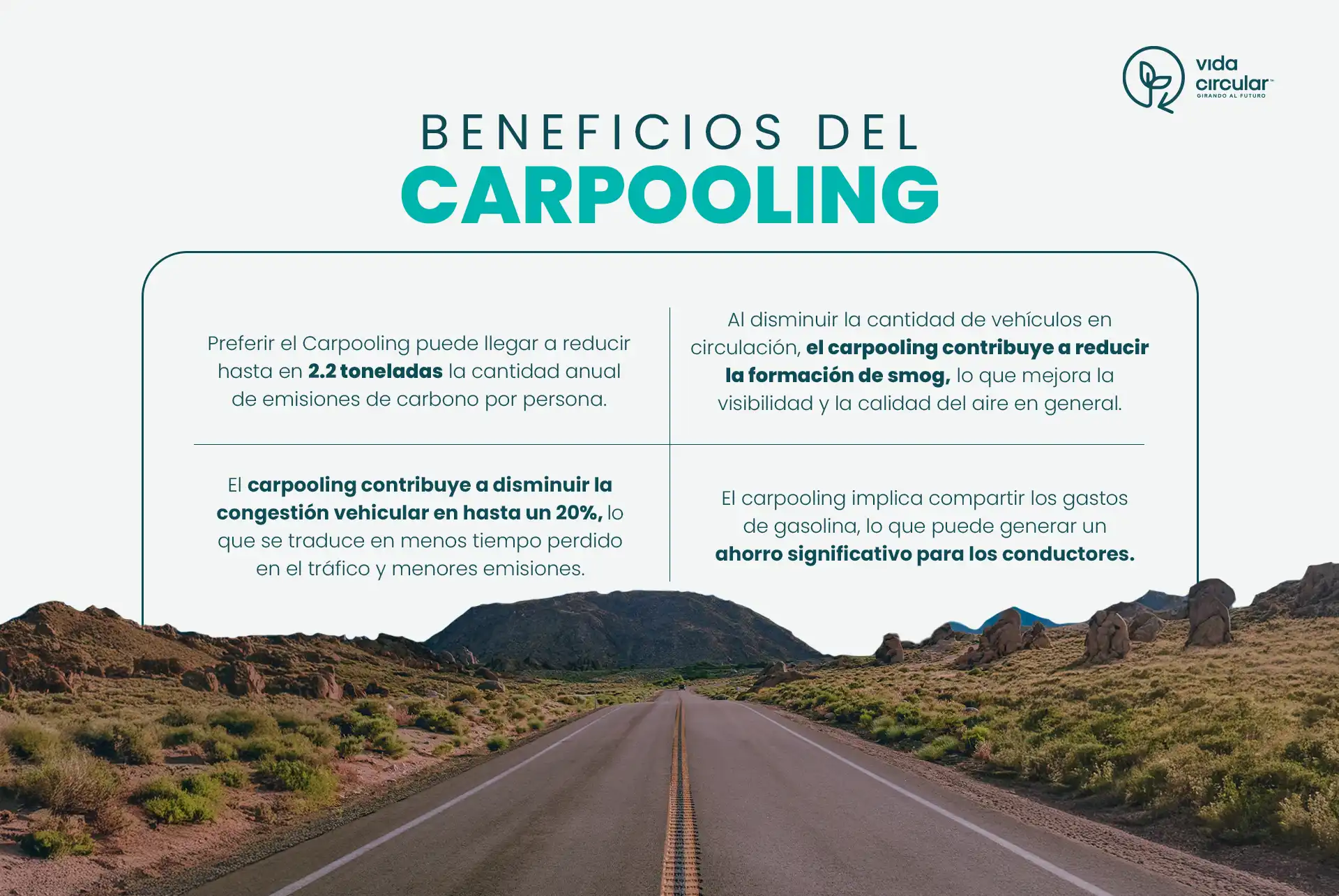
Carpooling as an environmentally friendly transportation solution
Carpooling, or car sharing, is a practice that allows several people to share a ride in a single vehicle to reach a common destination together. With this, we not only reduce the number of cars on the road, but we also make commuting more practical and friendly for everyone. We organize ourselves to go to work, school or social events together, dividing the costs of gasoline, parking and, when necessary, even tolls. This modality, also known as carpooling, has become an increasingly popular and accessible alternative, allowing us to transport ourselves more economically and with less environmental impact.
Another key advantage is its positive impact for companies that decide to encourage this practice among their employees, as it fosters an organizational culture committed to sustainability and well-being, which can strengthen the corporate image and attract both talent and customers who value social responsibility. Finally, by reducing the stress associated with traffic and individual transportation costs, it creates a healthier and more collaborative work environment.
Benefits of carpooling
When we all get in the same car and share the ride, the benefits go beyond just getting to a destination together. Carpooling transforms each trip into an opportunity to save money, reduce environmental impact and even strengthen our networks. Here we explore some of the advantages that make carpooling such an attractive option:
1.Cost reduction
By sharing the vehicle, each of us contributes our share and this is noticeable in the expenses. We split the costs of fuel, tolls and parking, making each trip much more economical. Thus, what used to represent a considerable expense is now much more affordable for everyone.
Less traffic
With fewer cars on the road, we all gain time and peace of mind. We reduce the number of vehicles in circulation, which helps improve traffic flow and shortens travel times. This is a benefit that we and other drivers in the city feel.
3. Environmental benefits
Every time we carpool, we are doing our bit to reduce polluting emissions. Fewer vehicles on the road means a smaller carbon footprint. footprinta breath of fresh air for the planet and an important step in the fight against climate change. climate change. It is a simple and effective way to contribute to the environment in our daily lives.
4. Socialization and networking
In addition to the economic and environmental benefits, carpooling allows us to connect and get to know better those who share our journey. These moments of travel become opportunities to chat, exchange ideas and strengthen ties. Whether with colleagues, neighbors or new acquaintances, carpooling gives us the possibility to expand our networks and make the trip more enjoyable.
In the end, carpooling is not just a form of transportation; it is a shared experience that brings us together on different levels and allows us to move in a more efficient, economical and socially enriching way.

How to implement carpooling in everyday life
Implementing carpooling into our routine may seem like quite a change at first, but with a few simple steps we can make this form of ridesharing a natural part of our daily lives. The most important thing is to organize ourselves well and take advantage of the tools we have at hand to make each trip pleasant and smooth for everyone. Here are some practical tips to get you started:
The first thing is to find people who follow a similar route to ours. Whether at work or at the university, we can organize to coordinate times and pick-up and drop-off locations that work for everyone. This way, it becomes easier and faster every day to coordinate shared rides.
Today, there are applications that make this organization even simpler and safer. These platforms connect us with others interested in carpooling and offer tools such as ratings and identity verification, which provide extra confidence. With these apps, we can find people with similar journeys and organize ourselves without complications.
A key aspect for carpooling to work well is to define some basic rules. It helps us to decide who will drive each day, how we will share the costs and the details of coexistence during the trip, such as keeping the space clean or deciding if there will be music or phone calls during the trip. These small rules ensure that we can all enjoy the trip and arrive comfortably and calmly.
With these simple steps, implementing carpooling in our daily lives becomes accessible and, above all, effective. In addition, we add a way of getting around that benefits both our pocket and the environment.
The role of carpooling in sustainable mobility
Carpooling is much more than a practical way to share a ride; it represents a real and sustainable solution for transportation in our cities. By opting for carpooling, we are actively contributing to reducing polluting gas emissions, decreasing our carbon footprint and using less non-renewable resources such as oil. It is an alternative to individual car use that allows us to have a positive impact on the environment and improve the quality of the air we all breathe.
In addition, carpooling helps to decongest our cities, where traffic is a daily problem for many of us. Every car less in circulation represents a relief for the streets and avenues, which translates into less time stuck in traffic jams and a smoother traffic flow. Imagine if many of us joined carpooling: the change would be felt in every journey, from the comfort of moving in a group to the satisfaction of knowing that we are doing something concrete for the planet.
This type of shared transport also plays a crucial role in sustainable mobility. It invites us to make more rational and shared use of the transportation resources we have, promoting a culture of collaboration rather than dependence on the private car. By integrating carpooling into urban mobility policies, we can foster a transportation model that makes better use of existing road infrastructure and supports a more efficient and environmentally friendly transportation network.
Conclusion on Carpooling for sustainable urban mobility
In the end, carpooling reminds us that the shift to a more sustainable world begins with simple, everyday decisions. It's not just about reducing costs or avoiding traffic; it's about taking responsibility for our environment and the people who share our city. By carpooling, we choose to put aside a little individualism to be part of something bigger, a collective effort to improve the quality of life in our communities and to leave a cleaner, more livable planet.
Beyond a fad or a transportation alternative, carpooling is an invitation to rethink how we move and how we influence our environment. What would happen if we all took a moment to reflect on our transportation choices? How much could we achieve if we decided to make every trip count not just for us, but for everyone?




